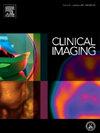Quantitative habitat concentration analysis of triple negative breast cancer on MRI correlates with pathologic response to combination neoadjuvant immuno/chemotherapy
IF 1.5
4区 医学
Q3 RADIOLOGY, NUCLEAR MEDICINE & MEDICAL IMAGING
引用次数: 0
Abstract
Objective
To determine if quantitative volumetric habitat concentration analysis of triple negative breast cancer (TNBC) on pre-treatment MRI correlates with neoadjuvant treatment response in patients treated with combination Talimogene Laherparepvec (TVEC) neoadjuvant immunotherapy and chemotherapy (NAIC).
Methods
Patients with TNBC in a single institution phase I/II trial from 5/2017–9/2020 underwent pre-treatment breast MRI followed by ultrasound-guided intratumoral TVEC injections and NAC prior to surgery. Pre-treatment MRIs were evaluated quantitatively using functional tumor volume (FTV) assessment and temporal voxel intensity categorization (high vs low plus phase of peak) to establish percentage habitat concentrations (%HC) for each quantitative method. These were correlated with pathologic response at surgery. Statistical analyses were performed using Mann Whitney U and comparison of proportions tests, with p < 0.05 considered statistically significant.
Results
Twenty-five female patients, aged 32–66 (avg 49), were included. Average %FTV and %High-Enhancement Volume (HEV) was 75.7 % and 87.1 %, respectively. Twelve patients (48 %) achieved pCR. On average, patients achieving pCR had higher %FTV (84.8 % vs 67.4 %, p = 0.022) and %HEV (93.3 % vs 81.3 %, p = 0.010). Patients with %HC above average for FTV and HEV also had lower average percent tumor cellularity (TC, 1 and 1.1 % vs 14.3 and 17.1 %, p = 0.023 and 0.003, respectively). Indeed, tumors with above average %FTV and %HEV achieved pCR in 71 % (10/14) and 69 % (11/16), respectively. In contrast, those below average achieved pCR in only 18 % (2/11) and 11 % (1/9), with p = 0.008 and 0.006, respectively.
Conclusion
Above-average concentration of functional tumor/high enhancement voxels within tumors before NAIC correlates with higher pCR rates and lower %TC at surgery.
三阴性乳腺癌MRI定量栖息地浓度分析与新辅助免疫/化疗联合病理反应的相关性
目的探讨三阴性乳腺癌(TNBC)治疗前MRI定量体积栖息地浓度分析与TVEC (Talimogene Laherparepvec, TVEC)联合新辅助免疫化疗(NAIC)患者新辅助治疗反应的相关性。方法2017年5月至2020年9月,在一项单机构I/II期临床试验中,TNBC患者术前接受乳房MRI检查,然后在手术前接受超声引导下肿瘤内TVEC注射和NAC。使用功能性肿瘤体积(FTV)评估和时间体素强度分类(高vs低加上峰相)定量评估预处理mri,以确定每种定量方法的栖息地浓度百分比(%HC)。这些与手术时的病理反应相关。采用Mann Whitney U检验和比例比较检验进行统计学分析,p <; 0.05认为有统计学意义。结果纳入25例女性患者,年龄32 ~ 66岁,平均年龄49岁。平均%FTV和%高增强体积(HEV)分别为75.7%和87.1%。12例患者(48%)获得pCR。平均而言,实现pCR的患者有更高的FTV % (84.8% vs 67.4%, p = 0.022)和HEV % (93.3% vs 81.3%, p = 0.010)。在FTV和HEV中,%HC高于平均水平的患者也有较低的平均肿瘤细胞百分率(TC, 1和1.1% vs 14.3和17.1%,p分别= 0.023和0.003)。事实上,高于平均水平%FTV和%HEV的肿瘤分别有71%(10/14)和69%(11/16)实现了pCR。相比之下,低于平均水平的只有18%(2/11)和11%(1/9)达到pCR, p分别= 0.008和0.006。结论NAIC前肿瘤内高于平均水平的功能肿瘤/高增强体素浓度与手术时较高的pCR率和较低的TC %相关。
本文章由计算机程序翻译,如有差异,请以英文原文为准。
求助全文
约1分钟内获得全文
求助全文
来源期刊

Clinical Imaging
医学-核医学
CiteScore
4.60
自引率
0.00%
发文量
265
审稿时长
35 days
期刊介绍:
The mission of Clinical Imaging is to publish, in a timely manner, the very best radiology research from the United States and around the world with special attention to the impact of medical imaging on patient care. The journal''s publications cover all imaging modalities, radiology issues related to patients, policy and practice improvements, and clinically-oriented imaging physics and informatics. The journal is a valuable resource for practicing radiologists, radiologists-in-training and other clinicians with an interest in imaging. Papers are carefully peer-reviewed and selected by our experienced subject editors who are leading experts spanning the range of imaging sub-specialties, which include:
-Body Imaging-
Breast Imaging-
Cardiothoracic Imaging-
Imaging Physics and Informatics-
Molecular Imaging and Nuclear Medicine-
Musculoskeletal and Emergency Imaging-
Neuroradiology-
Practice, Policy & Education-
Pediatric Imaging-
Vascular and Interventional Radiology
 求助内容:
求助内容: 应助结果提醒方式:
应助结果提醒方式:


